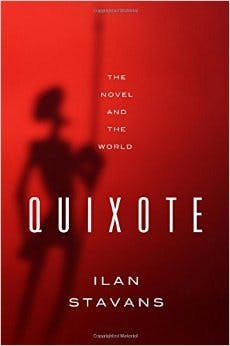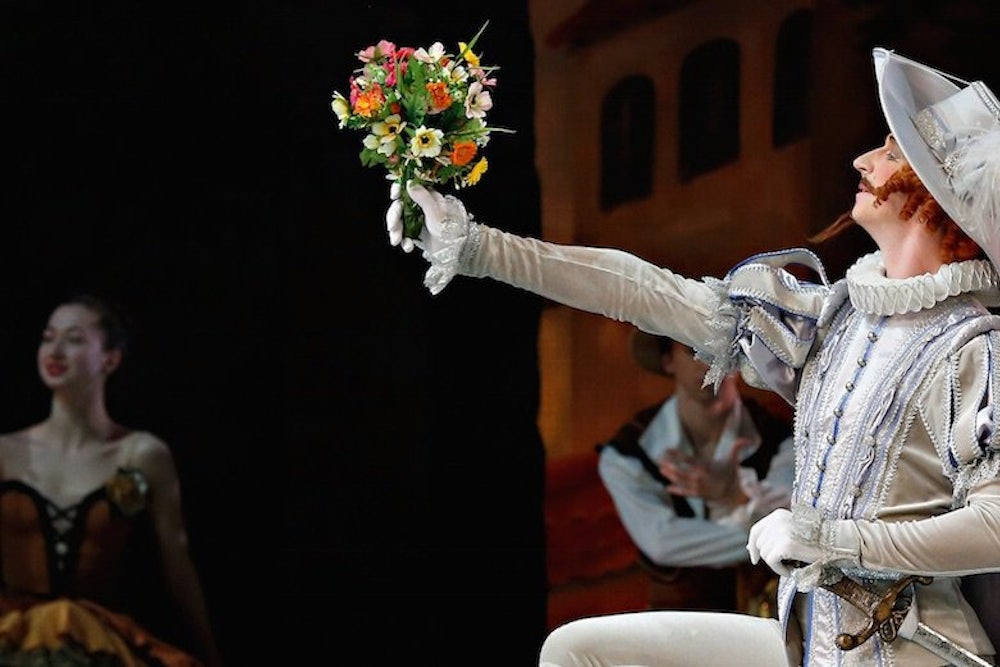Don Quixote is one of those books whose influence is so far-reaching as to be almost ubiquitous, like The Odyssey, or the Bible. And like the Bible or Homer’s epic, it is more often talked about than read. Yet what distinguishes Cervantes’s novel from these works is the fact that it is a decidedly low affair. It lumbers along: Its characters fall off horses, get drunk in taverns, and try to hold in their farts—in Don Quixote, sacred matters are usually confined to the delusions of its hero. Its famous opening sentence informs us that “somewhere in La Mancha, in a place whose name I do not care to remember, a gentleman lived not long ago, one of those who has a lance and an ancient shield on a shelf and keeps a skinny nag and a greyhound for racing”—clearly, we are very far from Ithaca or Bethlehem.
And yet the novel is a pillar of the canon. As the translator and literary scholar Ilan Stavans tells us in his new book, Quixote: The Novel and the World (W.W. Norton, 2015), only the Bible has been translated into English more often. There are seven ballets based on it, an asteroid named after it, and a video game inspired by it. I have even heard it told, by a professor who once taught a class on Don Quixote, that there is a sixties-era Danish porn adaptation out there somewhere. (It’s a rumor so outlandish that, Quixote-style, I had no choice but to instantly believe it.)

This year marks the 400th anniversary of the publication of the Second Part of Don Quixote—or, as Stavans determinedly calls it, El Quijote—and makes for a suitable occasion to examine why this odd, monotonous, funny, cruel, and strangely affecting novel has provoked so many disparate reactions over the centuries. Stavans, who claims to have spent his entire adult life wanting to be Don Quixote, proves an affable guide steeped in Quixotalia. His library, he tells us, aside from being littered with Quixote-inspired lunchboxes, action figures, postal stamps and advertisements, is jammed with translations of the novel in Yiddish, Korean, Quechua, and even Klingon.
The first half of Stavans’s Quixote helpfully digests much of the context of Cervantes’s world—Golden Age Spain, with its dwindling empire and bumbling, paranoid monarchs—and explores the enigmatic life of Don Quixote’s author. Stavans asks, a little verbosely, to what extent it is “accurate to visualize Cervantes through a Caucasian prism.” (A more straightforward way of putting this might have been, “Is it true that Cervantes was simply white?”) It has long been speculated that Cervantes may have been partly Jewish, while his decision to frame Don Quixote as a translation from the Arabic—the “first author” of the book is the fictional Arab historian Cide Hemete Benengeli—is suggestive of what Stavans calls an “intense interest in things Muslim.” What’s more, Spain in the late sixteenth century was something of melting pot of ethnicity and culture, and Cervantes’s travels in Italy, his frequent brushes with the law, and the five years he spent as a slave of Turkish pirates in Algeria, lends his status within the Catholic Spanish Empire a renegade luster.
But Stavans is mostly silent on the question of religion in Don Quixote, which is surprising given Cervantes’s supposed interest in Muslim culture and the novel’s many blasphemous barbs. And though Stavans is an admirably obsessive reader—in the mold of José Martínez Ruiz, who in 1905 published La ruta de don Quijote, a work of literary cartography in which the Spanish critic attempted to trace Don Quixote’s journey using the geographically inexact locations mentioned in the novel—literary obsession is not always consistent with cloudless literary judgment, and literary judgment is precisely what Stavans lacks.
Despite claiming to have read Don Quixote once a year, Stavans offers little engagement with the novel as a literary text. The nearest he comes to any kind of close reading is a rather offhand claim that “Cervantes was not a meticulous craftsman. His sentences go on and on and on and on, and so on.”
Well, yes, that much is clear to any reader of the novel’s very uneven, occasionally incoherent 940 pages—but what of it? It hardly accounts for Don Quixote’s greatness, its sophisticated playfulness, or its enduring appeal—all of which Stavans happily affirms, but without ever digging into the text himself. As a critic, he keeps his hands firmly in his pockets.
In Quixote’s second part (“The World”), Stavans’s reticence makes him guilty of outright complacency. It seems that everything anyone has ever said of the novel deserves to be mentioned, never mind how outlandish or contradictory or foolish. There is something alarming, for instance, about Stavans’s refusal to question or even comment on Che Guevara’s modeling himself after Don Quixote (perhaps while overseeing one of Cuba’s corrective work camps?), or the ease with which he dispatches throwaway lines such as, “The United States in the twenty-first century is as quixotic as ever.” But worst of all is Stavans’s indulgence of nebulous boilerplate like this:
Cervantes’s is the novel most translated into English because English speakers have identified it as a cornerstone of Western civilization; because they are drawn to it as a source of nourishment for the idealism ingrained in human nature; and because it is an open-ended classic that allows—nay, invites—for multiple interpretations.
By replacing Cervantes’s name and maybe one or two words, you could just as easily apply that passage to Madame Bovary or The Idiot—or, if we scrapped the first clause, Uncle Tom’s Cabin, To Kill a Mocking Bird, or the bathetic works of Paulo Coelho. It is a platitudinous and imprecise description of Don Quixote, let alone any novel one claims to love. Stavans, in fact, is guilty of serial imprecisions, and sometimes, outright howlers. He refers several times to Kafka’s “The Metamorphosis” as a novel (which it isn’t), and calls V. S. Pritchett, whose literary reputation rests entirely on his short fiction and literary essays, “a British novelist.”
These are small objections, perhaps, but they contribute to Quixote’s vaporous feel and tenuous prose. The book’s most arresting observation belongs to a friend of Stavans’s who, in the book’s epilogue, is quoted as saying, “You actually don’t like Don Quixote, let alone love it. You simply want to be associated with it.”
This is a very damning remark, and based on Quixote: The Novel and the World, it is also a fairly accurate one. Stavans appears to love the phenomenon of Don Quixote more than the novel itself. His book doesn’t bring the reader any closer to Cervantes’s elusive masterpiece, but rather offers up a fresh set of distractions—do we really need to know about every single individual in American public life to whom the adjective “quixotic” has been attached? Would it not have been worthwhile, instead, to engage a little critically with the text, venture some close reading, and offer a few novel observations about Cervantes’s writing, rather than simply repeat and refer to what others have already said?
“El Quijote is just another novel, in spite of its echoes,” Stavans writes in his book’s epilogue—an admission that comes too late, since the problem with his book is that it insists on regarding Don Quixote as anything but “just another novel.” Quixote: The Novel and the World is a book whose treatment of its subject lives up entirely to Mark Twain’s definition of a classic: “A book people praise but don’t read.” Stavans, unwisely, chose this for an epigraph. He has a lot of praise for Don Quixote and for Cervantes, but none of it seems especially connected to the act of reading.
If only Stavans had been a little less impressed by the grandeur of the novel, and a little less egalitarian in his summaries of its many rival interpretations and readings. For the trouble with Don Quixote is that no one agrees on what, if anything, the true cause of the make-believe Knight’s celebrated quest really is. There isn’t any agreement on what drives his insanity, or whether or not he’s even insane. And as is so often the case, the novel seems to anticipate the responses of its readers; as one character says to another, after spending some time in Don Quixote’s company: “Not all the physicians and notaries in the world could make a final accounting of his madness; he is a combination madman who has many lucid intervals.”
You don’t have to read far into the literature of Don Quixote to know that an astonishing amount of simpering nonsense has been written about it, and often by otherwise discerning writers. William Hazlitt, for example, wrote that, “the spirit the book breathes, to those who relish and understand it, is unquestionably the spirit of chivalry,” while the Spanish man of letters Miguel de Unamuno expended an inordinate amount of writing trying to save Don Quixote from his creator. It is instructive (and a little ironic) to observe how so many readers of this great novel are themselves driven to a kind of madness of misreading.
I know of no book that so consistently and subtly quashes its reader’s desire for wholeness and certainty as Cervantes’s novel does, and Stavans, to his credit, is right to say that if Shakespeare is the inventor of the human (in Harold Bloom’s phrase) then Cervantes is “the discoverer of doubt.” Don Quixote is a novel that guards itself against interpretation in a fortress of paradox and ambiguity—just like its hero. Spurred into action by an act of misreading, Cervantes’s Knight gradually becomes the subject of a story of reading and misreading, whose journey through Spain leaves everyone he encounters baffled by his “mixed speech […] sometimes intelligent, and sometimes utterly foolish.” Perhaps Cervantes would have appreciated the irony of his great novel suffering the same fate.
